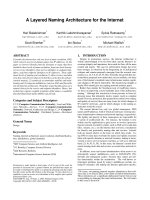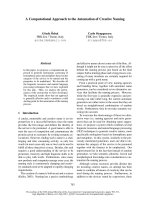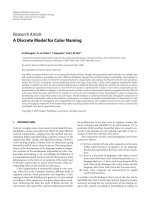Lecture05 naming
Bạn đang xem bản rút gọn của tài liệu. Xem và tải ngay bản đầy đủ của tài liệu tại đây (1.23 MB, 11 trang )
11/12/2015
Today…
IT4371: Distributed Systems
Spring 2015
Last Session:
Naming
Communication in Distributed Systems
Inter-Process Communication, Remote Invocation, Indirect Communication
Today’s Session:
Dr. Nguyen Binh Minh
Naming
Naming Conventions and Name Resolution Algorithms
Department of Information Systems
School of Information and Communication Technology
Hanoi University of Science and Technology
Naming
Names, Addresses and Identifiers
Names are used to uniquely identify entities in Distributed Systems
Entities may be processes, remote objects, newsgroups, …
Names are mapped to entities’ locations using name resolution
An entity can be identified by three types of references
1. Name
A name is a set of bits or characters that references an entity
Names can be human-friendly (or not)
2. Address
Every entity resides on an access point, and access point has an address
Addresses may be location-dependent (or not)
e.g., IP Address + Port
An example of name resolution
3. Identifier
Name
Identifiers are names that uniquely identify entities
:8888/WebExamples/earth.html
DNS Lookup
55.55.55.55
MAC address
Resource ID (IP Address, Port, File Path)
8888
WebExamples/earth.html
Host
02:60:8c:02:b0:5a
1
11/12/2015
Naming Systems
A naming system is simply a middleware that assists in name resolution
Naming systems are classified into three classes based on the type of names used:
a.
b.
c.
Flat naming
Structured naming
Attribute-based naming
Classes of Naming
Flat naming
Structured naming
Attribute-based naming
Flat Naming
1. Broadcasting
In Flat Naming, identifiers are simply random bits of strings (known as
unstructured or flat names)
Approach: Broadcast the identifier to the complete network. The entity
associated with the identifier responds with its current address
Flat name does not contain any information on how to locate an entity
Example: Address Resolution Protocol (ARP)
We will study four types of name resolution mechanisms for flat names:
1.
2.
3.
4.
Broadcasting
Forwarding pointers
Home-based approaches
Distributed Hash Tables (DHTs)
Resolve an IP address to a MAC address
In this application,
IP address is the identifier of the entity
MAC address is the address of the
access point
Who has the identifier
192.168.0.1?
Challenges:
Not scalable in large networks
This technique leads to flooding the network with broadcast messages
Requires all entities to listen to all requests
I am 192.168.0.1. My address is
02:AB:4A:3C:59:85
2
11/12/2015
Forwarding Pointers – An Example
2. Forwarding Pointers
Forwarding Pointers enable locating mobile entities
Stub-Scion Pair (SSP) chains implement remote invocation for mobile entities using
forwarding pointers
Each forwarding pointer is implemented as a pair:
Mobile entities move from one access point to another
When an entity moves from location A to location B, it leaves behind (at A) a
reference to its new location at B
(client stub, server stub)
The server stub contains a local reference to the actual object or a local reference to the remote
client stub
Name resolution mechanism
Follow the chain of pointers to reach the entity
Update the entity’s reference when the present location is found
When object moves from A to B,
It leaves a client stub in its place
It installs a server stub that refers to the new remote client stub on B
Challenges:
Long chains lead to longer resolution delays
Long chains are prone to failure due to
broken links
Process P2
Process P1
Process P3
Process P4
n
= Process n;
= Remote Object;
= Caller Object;
= Server stub;
= Client stub
3. Home-Based Approaches
3. Home-Based Approaches – An example
Each entity is assigned a home node
Home node is typically static (has fixed access point and address)
Home node keeps track of current address of the entity
Example: Mobile-IP
1. Update home node about the foreign
address
Entity-home interaction:
Entity’s home address is registered at a naming service
Entity updates the home about its current address (foreign address) whenever it moves
Name resolution
Client contacts the home to obtain the foreign address
Client then contacts the entity at the foreign location
Mobile entity
3a. Home node forwards the message
to the foreign address of the mobile
entity
Home node
2. Client sends the packet to the
mobile entity at its home node
3b. Home node replies the client with the
current IP address of the mobile entity
4. Client directly sends all subsequent
packets directly to the foreign address of
the mobile entity
3
11/12/2015
4. Distributed Hash Table (DHT)
3. Home-Based Approaches – Challenges
Home address is permanent for an entity’s lifetime
If the entity permanently moves, then a simple home-based approach incurs higher
communication overhead
DHT is a class of decentralized distributed system that provides a lookup service
similar to a hash table
(key, value) pair is stored in the nodes participating in the DHT
The responsibility for maintaining the mapping from keys to values is distributed among
the nodes
Any participating node can retrieve the value for a given key
Connection set-up overheads due to communication between the client and the
home can be excessive
Consider the scenario where the clients are nearer to the mobile entity than the home
entity
We will study a representative DHT known as Chord
DATA
Each node can be contacted through its network
address
Chord also maps each entity to an m-bit identifier
key
ASDFADFAD
cs.qatar.cmu.edu
Hash function
DGRAFEWRH
86.56.87.93
Hash function
4PINL3LK4DF
Each node is responsible for a set of entities
An entity with key k falls under the jurisdiction of the
node with smallest identifier id >= k. This node is
known as the successor of k, and is denoted by
succ(k)
Participating
Nodes
A Naïve Key Resolution Algorithm
Entity
with id k
Node n (node
with id=n)
The main issue in DHT-based solution is to efficiently resolve a key k to the network
location of succ(k)
Given an entity with key k on node n, how to find the node succ(k)?
000
003
30
Node 000
31
00
19
01
02
29
03
28
004
04
27
008
Entities can be processes, files, etc.
Mapping of entities to nodes
DISTRIBUTED NETWORK
Hash function
Chord
Chord assigns an m-bit identifier key (randomly
chosen) to each node
KEY
Pink Panther
05
26
Node 005
06
25
040
07
24
08
079
23
Node 010
09
22
540
10
21
11
20
Node 301
12
19
13
18
Match each entity with key k with
node succ(k)
n
17
= Active node with id=n
16
p
15
14
1. All nodes are arranged in a
logical ring according to
their keys
2. Each node ‘p’ keeps track of
its immediate neighbors:
succ(p) and pred(p)
3. If node ‘n’ receives a
request to resolve key ‘k’:
• If pred(p) < k <=p,
node will handle it
• Else it will simply forward it
to succ(n) or pred(n)
Solution is not scalable:
• As the network grows, forwarding delays increase
• Key resolution has a time complexity of O(n)
= No node assigned to key p
4
11/12/2015
Key Resolution in Chord
1
01
2
01
3
01
4
04
5
14
30
31
1
04
2
04
3
09
4
09
5
18
00
01
26
29
02
03
28
04
27
1
09
2
09
3
09
4
14
5
20
05
26
06
25
1
28
2
28
3
28
4
01
5
09
Chord improves key resolution by reducing
the time complexity to O(log n)
1. All nodes are arranged in a logical ring
according to their keys
2. Each node ‘p’ keeps a table FTp of atmost m entries. This table is called
Finger Table
FTp[i] = succ(p + 2(i-1))
07
24
08
23
09
22
10
21
21
2
28
11
2
11
3
14
4
18
5
28
11
20
1
1
12
19
13
18
3
28
1
20
4
28
2
20
5
04
3
28
4
28
5
04
17
16
15
14
1
14
2
14
3
18
1
18
4
20
2
18
5
28
3
18
4
28
5
01
NOTE: FTp[i] increases exponentially
Chord – Join and Leave Protocol
In large Distributed Systems, nodes dynamically
join and leave (voluntarily or due to failure)
30
00
01
02
03
28
Node p contacts arbitrary node, looks up for
succ(p+1), and inserts itself into the ring
Node p contacts pred(p), and updates it
3. If node ‘n’ receives a request to resolve
key ‘k’:
• Node p will forward it to node q with
index j in Fp where
q = FTp[j] <= k < FTp[j+1]
04
27
05
Who is
succ(2+1) ?
26
06
Who is
Succ(2+1)
succ(2+1)
? = 04
25
If node p wants to leave
07
24
Node 4 is
succ(2+1)
02
23
22
08
09
10
Who is
succ(2+1) ?
21
20
19
11
12
13
18
• If k > FTp[m], then node p will
forward it to FTp[m]
Classes of Naming
Flat naming
Structured naming
Attribute-based naming
31
29
If a node p that wants to join:
17
16
15
14
Structured Naming
Structured Names are composed of simple human-readable names
Names are arranged in a specific structure
Examples
File-systems utilize structured names to identify files
/home/userid/work/dist-systems/naming.txt
Websites can be accessed through structured names
www.soict.hust.edu.vn
5
11/12/2015
Name Spaces
Example Name Space
Structured Names are organized into name spaces
Looking up for the entity with name “/home/steen/mbox”
Name-spaces is a directed graph consisting of:
Data stored in n1
Leaf nodes
Directory node refers to other leaf or directory nodes
Each outgoing edge is represented by (edge label, node identifier)
Each node can store any type of data
e.g., type of the entity, address of the entity
n2
Leaf node
Directory node
Name Resolution
The process of looking up a name is called Name Resolution
Closure mechanism
Name resolution cannot be accomplished without an initial
directory node
Closure mechanism selects the implicit context from which to
start name resolution
keys
n1
elke
Directory nodes
n0
home
n2: “elke”
n3: “max”
n4: “steen”
Each leaf node represents an entity
Leaf node generally stores the address of an entity (e.g., in DNS), or the state of an entity (e.g.,
in file system)
n5
n4
n3
twmrc
“/keys”
steen
max
mbox
Name Linking
Name space can be effectively used to link two different entities
Two types of links can exist between the nodes
1.
2.
Hard Links
Symbolic Links
Examples
www.qatar.cmu.edu: start at the DNS Server
/home/steen/mbox: start at the root of the file-system
6
11/12/2015
1. Hard Links
2. Symbolic Links
There is a directed link from the hard link to the actual
node
“/home/steen/keys” is a hard
link to “/keys”
Name Resolution
home
– Similar to the general name
resolution
Constraint:
There should be no cycles in the
graph
n0
max
n2
n3
twmrc
“/home/steen/keys” is a
symbolic link to “/keys”
Name Resolution for a symbolic link SL
keys
n1
elke
Symbolic link stores the name of the original node as data
n5
steen
n4
“/keys”
First resolve SL’s name
Read the content of SL
Name resolution continues
with content of SL
keys
n1
elke
keys
mbox
n0
home
Constraint:
No cyclic references should be present
n2
n5
“/keys”
steen
max
n4
n3
twmrc mbox
keys
n6
Data stored in n6
Mounting of Name Spaces
Two or more name spaces can be merged transparently by a
technique known as mounting
In mounting, a directory node in one name space will store the
identifier of the directory node of another name space
Network File System (NFS) is an example where different name
spaces are mounted
NFS enables transparent access to remote files
“/keys”
Example of Mounting Name Spaces in NFS
Machine A
Name Space 1
remote
Machine B
Name Server for
foreign name
space
Name Space 2
home
vu
steen
mbox
“nfs://flits.cs.vu.nl/h
ome/steen”
OS
OS
Name resolution for “/remote/vu/home/steen/mbox” in a distributed file system
7
11/12/2015
Layers in Distributed Name Spaces
Distributed Name Spaces
In large Distributed Systems, it is essential to distribute name spaces over multiple
name servers
Distributed Name Spaces can be divided into three layers
High
Layer
• Consists of high-level directory nodes
• Directory nodes are jointly managed by different administrations
• Contains mid-level directory nodes
• Directory nodes grouped together in such a way that each group is managed by
an administration
Middle Layer
Low Layer
• Contains low-level directory nodes within a single administration
• The main issue is to efficiently map directory nodes to local name servers
Comparison of Name Servers at Different Layers
Distributed Name Spaces – An Example
Global
Administrational
Managerial
Geographical scale of the network
Worldwide Organization
Department
Total number of nodes
Few
Many
Many
None or few
Vast numbers
Number of replicas
Update propagation
Lazy
Immediate
Immediate
Is client side caching applied?
Yes
Yes
Sometimes
Responsiveness to lookups
Seconds
Milliseconds
Immediate
None
8
11/12/2015
Distributed Name Resolution
Distributed Name Resolution is responsible for mapping names to address
in a system where:
Name servers are distributed among participating nodes
Each name server has a local name resolver
We will study two distributed name resolution algorithms:
1. Iterative Name Resolution
2. Recursive Name Resolution
1. Iterative Name Resolution
1. Client hands over the complete name to root name server
2. Root name server resolves the name as far as it can, and returns the
result to the client
•
The root name server returns the address of the next-level name server (say,
NLNS) if address is not completely resolved
3. Client passes the unresolved part of the name to the NLNS
4. NLNS resolves the name as far as it can, and returns the result to the
client (and probably its next-level name server)
5. The process continues till the full name is resolved
1. Iterative Name Resolution – An Example
2. Recursive Name Resolution
Approach
Client provides the name to the root name server
The root name server passes the result to the next name server it finds
The process continues till the name is fully resolved
Drawback:
Large overhead at name servers (especially, at the high-level name
servers)
<a,b,c> = structured name in a sequence
#<a> = address of node with name “a”
Resolving the name “ftp.cs.vu.nl”
9
11/12/2015
2. Recursive Name Resolution – An Example
Classes of Naming
Flat naming
Structured naming
Attribute-based naming
<a,b,c> = structured name in a sequence
#<a> = address of node with name “a”
Resolving the name “ftp.cs.vu.nl”
Attribute-based Naming
Light-weight Directory Access Protocol (LDAP)
LDAP Directory Service consists of a number of records called “directory entries”
In many cases, it is much more convenient to name, and look up entities by means of their
attributes
Similar to traditional directory services (e.g., yellow pages)
However, the lookup operations can be extremely expensive
They require to match requested attribute values, against actual attribute values, which needs
to inspect all entities
Each record is made of (attribute, value) pair
LDAP Standard specifies five attributes for each record
Directory Information Base (DIB) is a collection of all directory entries
Each record in a DIB is unique
Each record is represented by a
distinguished name
e.g., /C=NL/O=Vrije Universiteit/OU=Comp. Sc.
Solution: Implement basic directory service as database, and combine with traditional
structured naming system
We will study Light-weight Directory Access Protocol (LDAP); an example system that uses
attribute-based naming
10
11/12/2015
Directory Information Tree in LDAP
All the records in the DIB can be organized into a hierarchical tree called Directory
Information Tree (DIT)
Summary
Naming and name resolutions enable accessing entities in a
Distributed System
Three types of naming
Flat Naming
Home-based approaches, Distributed Hash Table
Structured Naming
Organizes names into Name Spaces
Distributed Name Spaces
LDAP provides advanced search mechanisms based on attributes by traversing the
DIT
Example syntax for searching all Main_Servers in Vrije Universiteit:
Attribute-based Naming
Entities are looked up using their attributes
search("&(C = NL) (O = Vrije Universiteit) (OU = *) (CN = Main server)")
Next Class
Concurrency and Synchronization
Explain the need for synchronization
Analyze how computers synchronize their clocks and access resources
Clock Synchronization Algorithms
Mutual Exclusion Algorithms
References
/> /> /> /> />
11









